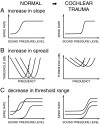Recruitment of neurons and loudness. Commentary on "Encoding intensity in ventral cochlear nucleus following acoustic trauma: implications for loudness recruitment" by Cai et al. J. Assoc. Res. Otolaryngol. DOI: 10.1007/s10162-008-0142-y
- PMID: 19159978
- PMCID: PMC2644387
- DOI: 10.1007/s10162-009-0156-0
Recruitment of neurons and loudness. Commentary on "Encoding intensity in ventral cochlear nucleus following acoustic trauma: implications for loudness recruitment" by Cai et al. J. Assoc. Res. Otolaryngol. DOI: 10.1007/s10162-008-0142-y
Figures

Comment on
-
Encoding intensity in ventral cochlear nucleus following acoustic trauma: implications for loudness recruitment.J Assoc Res Otolaryngol. 2009 Mar;10(1):5-22. doi: 10.1007/s10162-008-0142-y. Epub 2008 Oct 15. J Assoc Res Otolaryngol. 2009. PMID: 18855070 Free PMC article.
References
-
- None
- Bacon SP, Oxenham AJ. Psychophysical manifestations of compression: hearing-impaired listeners. In: Bacon SP, Fay RR, Popper AN (eds) Compression: from cochlea to cochlear implants. New York, Springer, pp. 107–152, 2004.
-
- {'text': '', 'ref_index': 1, 'ids': [{'type': 'PubMed', 'value': '2600627', 'is_inner': True, 'url': 'https://pubmed.ncbi.nlm.nih.gov/2600627/'}]}
- Blackburn CC, Sachs MB. Classification of unit types in the anteroventral cochlear nucleus: PST histograms and regularity analysis. J. Neurophysiol. 62:1303–1329, 1989. - PubMed
-
- {'text': '', 'ref_index': 1, 'ids': [{'type': 'PubMed', 'value': '2358869', 'is_inner': True, 'url': 'https://pubmed.ncbi.nlm.nih.gov/2358869/'}]}
- Blackburn CC, Sachs MB. The representations of the steady-state vowel sound/ɛ/ in the discharge patterns of cat anteroventral cochlear nucleus neurons. J. Neurophysiol. 63:1191–1212, 1990. - PubMed
-
- {'text': '', 'ref_index': 1, 'ids': [{'type': 'DOI', 'value': '10.1121/1.407484', 'is_inner': False, 'url': 'https://doi.org/10.1121/1.407484'}, {'type': 'PubMed', 'value': '8227752', 'is_inner': True, 'url': 'https://pubmed.ncbi.nlm.nih.gov/8227752/'}]}
- Boettcher FA, Salvi RJ. Functional changes in the ventral cochlear nucleus following acute acoustic overstimulation. J. Acoust. Soc. Am 94:2123–2134, 1993. - PubMed
-
- Cai S. Intensity encoding of ventral cochlear nucleus neurons in normal and deafened cats and correlates of loudness recruitment. Unpublished Master’s thesis. Department of Biomedical Engineering. The Johns Hopkins University, Baltimore, MD, 2007.
Publication types
MeSH terms
LinkOut - more resources
Full Text Sources

